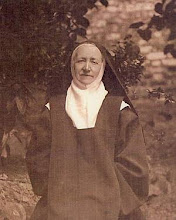Shortly before midnight the brethren rise and repair to the choir, where at the twelfth stroke of the hour they continue Matins according to the Roman rite. The singing is not plain chant, as in the monasteries of the Benedictine, Trappist or Carthusian Orders, but a simple kind of monotone, which, however, is not devoid of solemnity. Matins last about an hour and a quarter, followed by a short meditation before the Blessed Sacrament. The Midnight Office is of great importance; at a time when the world is forgetful of God, or even grievously offending His majesty, the Church, through her various Religious Orders, presents herself in supplication before His throne, praising His glorious name, and expiating for the world’s sinfulness.
About 2 a.m. the monks are back in their cells to take some repose: not an easy thing to do on cold winter nights. They rise again before five to chant Prime and Terce and make an hour’s meditation which is followed by
The true home of the monk is his cell. This is about twelve foot long by ten in width. Its furniture is of the simplest kind; the bed consists of a board, six feet by two and a half or three feet, resting on trestles, and covered with some blankets and a pillow. There is a writing table, with shelves for books, and a chair. On the walls are a cross and some pious pictures.
At half past ten Sext and None are recited in choir, followed at eleven by dinner. This is the first, and during the greater part of the year the only, meal. Those, however, who are unable to keep such a long fast can easily obtain permission to take a cup of coffee after
After dinner there is an hour’s recreation in common, but during the rest of the day silence is strictly enjoined. At two o’clock Vespers are chanted, frequently followed by the Office of the Dead. The afternoon is devoted to work, only interrupted by an hour’s meditation. In the evening there is a second meal, followed by a short recreation in summer, but in winter there is only a small collation. Compline and Night Prayers having been said, the Religious retire to their cells at about half past seven.
